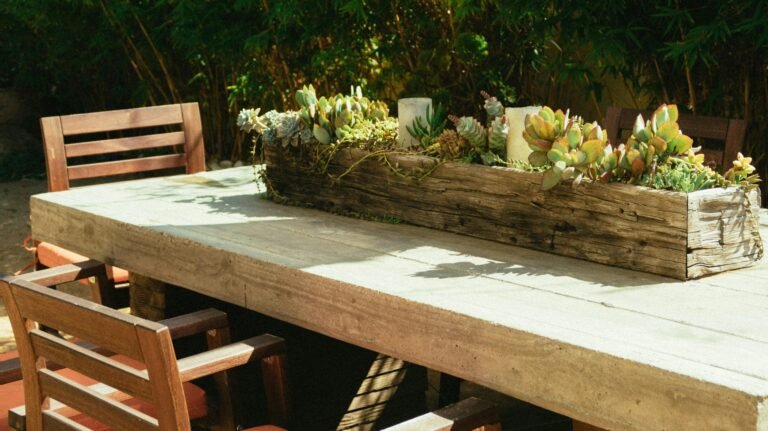Stop me if this sounds familiar…
You’ve got a little patch of outdoor space — maybe a balcony, a courtyard, or a narrow garden — and every time you step outside, you think, “What can I even do with this?” It feels too small to make a real difference, and the beautiful Pinterest-perfect gardens seem completely out of reach.
You’re not alone. Small garden spaces can feel more limiting than inspiring at first. But here’s the truth: size isn’t what makes a garden great — it’s what you do with it. And with the right ideas, even the tiniest plot can feel like a private oasis.
Whether you’re renting, on a tight budget, or just don’t know where to start, this guide is for you. You’ll walk away with smart, simple design ideas that will help your small garden feel bigger, brighter, and more put-together — without needing a landscaping degree or a big spend.
Let’s turn that small space into something that makes a big impact.
1. Think Vertical: Use Walls, Trellises & Hanging Planters
When floor space is limited, the only way is up. Vertical gardening is one of the easiest ways to add greenery and life to a small space without cluttering the ground.
Start with your walls or fences. A few mounted planters or hanging pots can instantly lift the eye and make the space feel taller. If you’ve got a balcony railing, use it — clip-on planter boxes are made for exactly this. Even an old wooden ladder leaned against a wall can become a quirky vertical plant stand.
Trellises are another powerful trick. You can train climbing plants like jasmine, clematis, or even runner beans to grow up them. It adds height, softness, and a lovely scent — without stealing floor space.
And don’t underestimate hanging planters. Pop them from pergolas, beams, or even sturdy hooks on a wall. Ferns, trailing ivy, or bright geraniums all look great when they spill down from above.
Quick tip: Group your vertical elements in odd numbers — it feels more balanced and intentional. And mix up the textures (wood, terracotta, metal) for a more layered look.
Vertical gardening doesn’t just save space — it creates depth, colour, and character. It turns a blank wall into a living feature.
2. Multipurpose Furniture & Smart Layouts
In a small garden, every item needs to earn its keep. That means choosing furniture that’s not just stylish, but also smart.
Look for foldable or stackable pieces. A bistro table and chairs that fold away can give you flexibility — perfect for turning a morning coffee spot into an evening hangout. If you’ve got a bit more space, go for a bench with hidden storage underneath. It gives you a place to sit and stash your cushions or tools.
Modular furniture is another clever option. These are pieces that you can rearrange depending on your needs — like stools that double as side tables, or a corner sofa that splits into smaller seats.
Layout matters, too. Push bigger items to the edges and keep the centre open — it’ll make your space feel roomier. And if you can, create defined “zones” for lounging, dining, or planting. Even in a tiny space, this helps things feel more intentional and less cramped.
Pro tip: Round tables often work better than square ones in small spaces — they’re easier to move around and feel softer visually.
With the right layout and multifunctional furniture, your garden becomes more than just a pretty space — it’s somewhere you’ll actually use.
3. Containers, Raised Beds & Portable Planters
If you’re dealing with paving, decking, or renting (so digging up the ground is a no-go), containers are your best friend.
Container gardening gives you total control — over the soil, the layout, and even the style. You can group pots together for impact, scatter them in corners to soften edges, or line them up along a wall like a mini hedge.
Raised beds are great if you’ve got a bit more space or want to grow herbs or veg. They keep things neat, are easier on your back, and can be built to fit your exact layout. Bonus: they help with drainage, which is handy in wetter climates.
Portable planters like wheeled troughs or crates are perfect if you like to mix things up. You can chase the sun, switch up your layout for a party, or just move plants indoors when winter hits.
Style tip: Don’t stick to one type of pot. Mix materials like terracotta, ceramic, and painted metal to create texture. Just make sure they all have drainage holes — soggy roots are a killer in container gardening.
With containers and raised beds, you’re not limited by the shape or quality of your garden. You create the structure — and that’s where the magic starts.
4. The Power of Lighting & Mirrors
Lighting isn’t just for indoors — it’s one of the simplest ways to make your garden feel cosy, spacious, and usable well into the evening.
Start with string lights. They’re cheap, easy to hang, and instantly create atmosphere. Drape them across a fence, along a railing, or overhead between two walls to add a warm glow and a sense of enclosure. Solar lanterns or LED candles are great for setting the mood — no plugs needed, and no fire risk.
Now for the underrated trick: mirrors. A well-placed outdoor mirror can double your greenery, reflect light into dark corners, and make your garden look twice as big. Just be sure to position it where it won’t reflect direct sun (that can scorch plants) and go for a style that fits your garden’s vibe — rustic wood, antique metal, or even an old window frame.
Design tip: Treat your garden like an outdoor room. Think about how you light and decorate your living room, then adapt those ideas outdoors.
Lighting and mirrors aren’t just decorative. They’re space-stretching, vibe-boosting tools that bring a touch of magic — especially when the sun goes down.
5. Add Colour, Texture & Height with Plants
Plants are the heart of any garden, but in a small space, you need to be a bit more strategic. It’s not about cramming in as many as possible — it’s about choosing ones that do more than one job.
Start by mixing heights. Use taller plants like ornamental grasses, dwarf trees, or bamboo at the back or in corners to draw the eye upward. Then layer in mid-height shrubs and low-growing ground cover to create depth. Even one tall statement plant can make a small space feel more dynamic.
Play with texture too. Contrast glossy leaves with feathery ferns or spiky succulents. It keeps things interesting without needing loads of different plants.
And don’t forget colour. Go bold with bright flowers like geraniums, petunias or nasturtiums if you want impact. Or stick to a more muted palette — whites, greens, and purples — for a calm, modern vibe.
Low-maintenance favourites? Try lavender, heuchera, hostas, or trailing ivy. They’re hardy, beautiful, and won’t demand constant attention.
Quick tip: Group plants in odd numbers and vary the pot sizes for a more natural look. Repetition creates rhythm, but variety adds life.
With the right mix of plants, your small garden doesn’t just look good — it feels alive.
6. Quick Wins: Budget-Friendly Styling Ideas
You don’t need a big spend to make a small garden feel polished. Sometimes it’s the little styling touches that bring the whole space together — and most of them won’t break the bank.
Start by repurposing what you’ve got. Old crates can become plant stands. Tin cans, teacups or colanders can be turned into quirky planters. A tired wooden chair? Give it a lick of paint and make it a garden feature.
Outdoor rugs instantly add colour and help define different zones. You’ll find affordable ones online or in high-street shops, and they’re made to survive the weather. Pair it with a couple of bright cushions or a throw to make the space feel more “lived in.”
Then there’s DIY decor — think painted pots, fairy lights in jam jars, or a pallet turned into a vertical herb garden. These small touches add personality and charm without costing much.
Design tip: Stick to one or two accent colours (like navy and mustard, or green and terracotta) so your space feels cohesive, not cluttered.
With a few creative tweaks and a touch of personality, even the barest balcony can feel like a magazine spread.
7. Privacy Without Building Walls
Just because your garden is small doesn’t mean it should feel exposed. Whether it’s nosy neighbours or just wanting a more enclosed feel, you can create privacy without blocking out light or space.
Start with tall potted plants. Bamboo is a popular choice — it grows fast, creates a lush screen, and sways beautifully in the breeze. Just keep it in a container unless you want it to take over. Tall grasses like Miscanthus or even potted trees like olive or bay are also great for soft, natural barriers.
Outdoor screens are another smart option. You can buy ready-made bamboo, slatted wood, or even metal ones — or DIY a pallet into a rustic panel. They don’t take up much room and instantly give your space a more intimate feel.
Then there’s the living version: climbing plants. Use trellises or wires against a wall or railing and grow climbers like clematis, honeysuckle, or sweet peas. You get privacy and flowers.
Bonus tip: Hanging fabric — like outdoor curtains or shade sails — adds a breezy, relaxed vibe while giving you coverage when and where you need it.
With a few vertical tricks, you can make your small garden feel like a private retreat — no brick walls required.
8. Final Tips to Bring It All Together
Small garden design isn’t about doing more — it’s about doing the right things. A few clever choices can turn even the tiniest space into somewhere that feels calm, beautiful, and totally you.
Here’s how to pull everything together:
- Pick a theme or vibe. Modern and minimal? Rustic and wild? Colourful and eclectic? Choosing a style helps guide your plant choices, furniture, and accessories.
- Keep it tidy. Clutter builds up fast in small spaces. Use storage benches or baskets to keep things neat without sacrificing style.
- Think seasonally. Mix in some evergreen plants or lighting so your garden still looks good when summer’s over.
- Start small. You don’t need to do it all in one weekend. Try one idea, see how it feels, and build from there.
Most importantly? Use your space. Sit in it. Eat out there. Have a morning coffee or a glass of wine in the evening. It’s not just a garden — it’s an extra room in your home.
Big impact doesn’t need big space. It just needs intention, a little creativity, and a few good ideas — and now, you’ve got those in your back pocket.
Alex is the creator of Homely Haven, a space dedicated to simple, stylish ideas for interiors and gardens alike. With a passion for cozy living rooms, inviting outdoor spaces, and practical DIY solutions, Alex shares tips and guides that help turn any house into a true home.
From budget-friendly decorating hacks to weekend garden projects, the goal is always the same: to inspire you to create spaces that feel personal, beautiful, and welcoming. When not writing, Alex is usually rearranging furniture, sketching new garden layouts, or exploring design trends for the next project.








